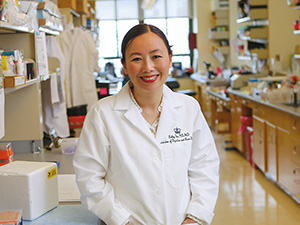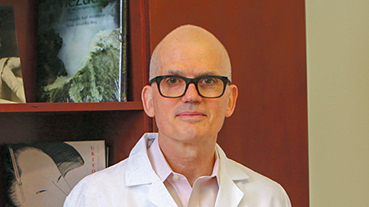Revealing the Role of Stem Cells in Gut Regeneration

Dr. Kelley Yan
In the laboratory of Kelley Yan, MD, PhD, a gastroenterologist in the Division of Digestive and Liver Diseases, NewYork-Presbyterian/Columbia University Irving Medical Center, and the Dorothy L. and Daniel H. Silberberg Assistant Professor of Medicine at Columbia, recent studies of intestinal stem cells are shedding light on the mechanisms of gut regeneration in normal circumstances and under conditions of injury. As a physician-scientist, Dr. Yan has set her sights on applying the discoveries made in her lab to improve tissue healing and treatment for the many diseases that can affect the gut.
“The intestinal epithelium is the most rapidly self-renewing tissue in the body and its vigorous regeneration is enabled by highly active intestinal stem cells,” says Dr. Yan, whose interest in gastroenterology and training in basic science research began as a medical student in the combined MD/PhD program at the Icahn School of Medicine at Mount Sinai.
“The intestinal epithelium is the most rapidly self-renewing tissue in the body and its vigorous regeneration is enabled by highly active intestinal stem cells.”
— Dr. Kelley Yan
It was only a short time before Dr. Yan began her GI fellowship and a postdoctoral research fellowship conducting studies in intestinal stem cell (ISC) biology at Stanford University that scientists, for the first time, had identified and isolated a stem cell in the gut. The timing was fortuitous, helping to solidify
Today, the Yan Laboratory at Columbia focuses on understanding tissue renewal in health and disease using the intestine as a model system to study adult stem cell biology.
ISCs: Understanding How They Replenish and Repair
To better understand the behavior of stem cells, Dr. Yan and her team use mouse models and also human organoids derived from patient tissues that are grown as “mini-guts” in dishes to study intestinal stem cells as they divide to produce more cells to endlessly replenish or repair the intestinal epithelium.
“The intestine is remarkably dynamic,” says Dr. Yan. “Cells that line the intestine get replaced every few days throughout life by new cells generated by intestinal stem cells. These stem cells are the mother of all other cells. They face the most decisions. Stem cells generate more stem cells but they also generate all the mature cell types that work in nutrient absorption, hormone secretion, and interfacing with the external world. So the main question that we had was, ‘Given all its choices, how does a stem cell actually decide what it wants to do? Is a stem cell hardwired to act in a predictable fashion or can we alter its behavior?’”
For Dr. Yan this is the most fundamental question in stem cell biology, with an answer that she and her team deciphered in the intestine itself. “It turns out that the intestinal stem cell takes instructional cues from its environment. In fact, it requires multiple types of signals from its surroundings,” explains Dr. Yan. “It requires Wnts and R-spondins, which are signals released by other cells in the vicinity. Wnts convey a signal to the stem cells that they are in the right location and prepares them to act. R-spondins then instruct them to divide and to generate more stem cells. Stem cells are so powerful that two separate signals are needed to activate their power. If either signal is lost, then ‘stemness’ is lost and a stem cell becomes just another typical cell destined to die after a few days.”

A single intestinal stem cell repairs an entire patch of tissue (green) in seven days after injury, highlighting its regenerative capacity.
“These signals not only control tissue regeneration, but they also are involved in the development of cancer,” continues Dr. Yan. “Colorectal cancer, for example, starts from mutations within the Wnt pathway, which is activated by the Wnts and R-spondins that control stem cell behavior. There is growing evidence that cancer originates from a runaway stem cell that no longer is reliant on environmental signals for its activity.”
The results of the research of Dr. Yan and her colleagues, which were published in the May 11, 2017, edition of Nature, provided a major advance in identifying discrete and separate functions of the Wnt and R-sponden proteins.
“We developed tools for manipulating levels of Wnts and R-spondins that enabled us to identify their function within an animal,” notes Dr. Yan. “Essentially, we revealed the external cues that a stem cell receives from its environment to enable it to act as a stem cell. We were very excited to discover that stem cell behavior is malleable. We were able to easily manipulate stem cells to make the choices we desired once we de-coded and understood their signals. This has broad implications for precision control of tissue regeneration and for treatment of cancer.”
The Yan Lab at Columbia is focused on bringing these findings into clinical practice. “My love for clinical gastroenterology drew me to the science, and my goal is to help patients through our discoveries,” says Dr. Yan. “If we can understand the mechanisms for how the gut normally regenerates and how it regenerates under conditions of injury, then we will actually be able to promote and enhance the process of healing after injury.”
“The gut is really interesting because it has so many different functions,” continues Dr. Yan. “It absorbs nutrients and it is our major interface with the outside world and with the immune system. The gut is also a powerful endocrine organ that regulates appetite and metabo- lism. I want to use stem cell biology to enhance all those functions.”
Dr. Yan notes that one of her long-term goals is to use stem cell biology to enhance the gut’s endocrine function. “We have shown that we can manipulate stem cell behavior to influence the types of cells produced in the gut. I want to figure out how to make more of the types of cells that would optimize our metabolism to treat diseases like obesity and diabetes, which we normally think of as endocrine rather than GI diseases. My vision is to ultimately tailor your gut cells to your individual needs — a designer gut, if you will.”
Reference Article
Yan KS, Janda CY, Chang J, Zheng GXY, Larkin KA, Luca VC, Chia LA, Mah AT, Han A, Terry JM, Ootani A, Roelf K, Lee M, Yuan J, Li X, Bolen CR, Wilhelmy J, Davies PS, Ueno H, von Furstenberg RJ, Belgrader P, Ziraldo SB, Ordonez H, Henning SJ, Wong MH, Snyder MP, Weissman IL, Hsueh AJ, Mikkelsen TS, Garcia KC, Kuo CJ. Non-equivalence of Wnt and R-spondin ligands during Lgr5+ intestinal stem-cell self-renewal. Nature. 2017 May 11;545(7653):238-42.
Related Publications




